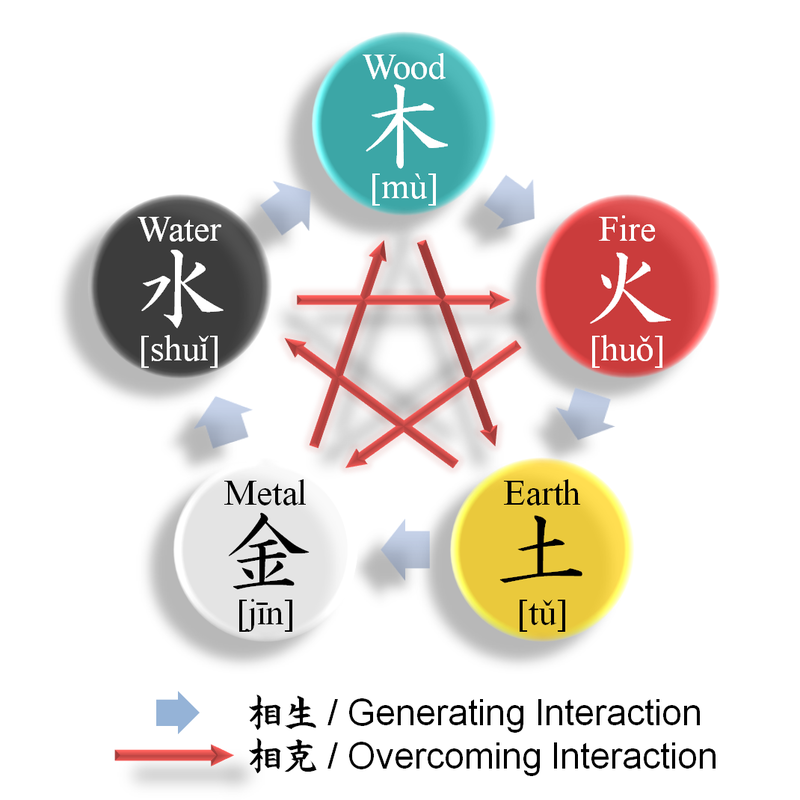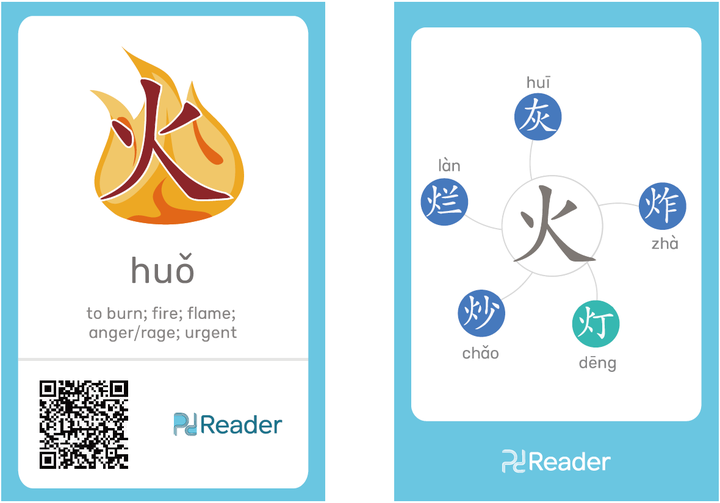13
03
2024
Of the 50 Chinese Radicals that are used in creating over 65% of Chinese common characters, today, we will learn the radicals: “火(huǒ)”. This radical means fire, light, flame, or anything connected with “fire”, ”light”, or “flame”.
In Chinese culture, there are 5 properties that are used to characterize all beings in nature. “火” is one of them. Therefore, characters or words that contain this radical have or are connected with the property. It is believed that the property helps define whether one object can assist or hinder the other. (If you play Pokémon Go, you probably are familiar with the dynamics of the creatures having different properties in the game.)
Please note that “radical” is an important concept in Chinese writing. A radical may be a word when used by itself, but it can also be used (like a building block) to construct other Chinese characters. Moreover, Chinese characters can be combined to formulate new words! Thus, learning these powerful radicals can help you learn Chinese writings effectively.

Source: Wikipedia

Source: Ponddy Education
Comments : No Comments »
Categories : Chinese Building Blocks
13
03
2024
“土 (tǔ): meaning earth” is one of the 50 powerful Chinese radicals used in creating over 65% of Chinese common characters. This radical means earth, ground or soil or anything connected with “earth”. “ground”, or ”soil”.
In Chinese culture, “土” is one of the five properties “五行 (wǔxíng)“ used to characterize beings in nature. It is believed that the objects that are connected with the “土” property can help those with the “金 (jīn): meaning metal” (I.e. “土生金: from ground unearth the metal”). On the other hand, it would hinder those with property “水(shuǐ): meaning water or liquid”.
Please note that “radical” is an important concept in Chinese writing. A radical may be a word when used by itself, but it can also be used (like a building block) to construct other Chinese characters. Moreover, Chinese characters can be combined to formulate new words! Thus, learning these powerful radicals can help you learn Chinese writings effectively.

source: wikipedia

Source: Ponddy
Comments : No Comments »
Categories : Chinese Building Blocks
18
03
2015
Audio words with 繁體 and 简体 :
六根 / 六根 – The six indriyas or sense-organs: eye, ear, nose, tongue, body, and mind.
眼根 / 眼根 – the eye and the visual.
耳根 / 耳根 – the ear and the hearing capability.
鼻根 / 鼻根 – the nose and the smelling.
舌根 / 舌根 – the tongue and the tasting capability.
身根 / 身根 – the body and the senses of touch.
意根 / 意根 – the mind and the ability to differentiate.
…
Read the rest of this entry »
Comments : No Comments »
Categories : Audio & Lessons, Buddhism
18
03
2015
Audio words with 繁體 and 简体 :
六塵 / 六尘 – The six guṇas, qualities produced by the objects and organs of sense that are the cause of all impurity. (sight, sound, smell, taste, touch, and idea)
色塵 / 色尘 – sight, such as color and form
聲塵 / 声尘 – sound
香塵 / 声尘 – smell or scent
味塵 / 味尘 – taste
觸塵 / 触尘 – touch
法塵 / 法尘 – though or idea that arises from differentiating the previous 5
…
Read the rest of this entry »
Comments : No Comments »
Categories : Audio & Lessons, Buddhism
18
03
2015
Audio words with 繁體 and 简体 :
六識 /六识 – The six parijñāna, or kinds of cognition, perception, or consciousness.
眼識 / 眼识 – caksur-vijñāna, eye consciousness or seeing
耳識 / 耳识 – śrotra-vijñāna, ear consciousness or hearing
鼻識 / 鼻识 – ghrāna-vijñāna, nose conciousness or smelling
舌識 / 舌识 – jihvā-vijñāna, tongue conciousness or tasting
身識 / 身识 – kāya-vijñāna, cognition of the objects of touch
意識 / 意识 – mano-vijñāna, the mental sense or intellect
…
Read the rest of this entry »
Comments : No Comments »
Categories : Audio & Lessons, Buddhism
4
03
2015
Audio words with 繁體 and 简体 :
六波羅蜜 / 六波罗蜜 – The six pāramitās, the six things that ferry one beyond the sea of mortality to nirvāṇa
布施 / 布施 – dāna, charity, including the bestowing of the truth on self and others
持戒 / 持戒 – śīla, keeping the command rents
忍辱 / 忍辱 – ksānti, patience under insult
精進 / 精进 – vīrya, zeal and progress
禪定 / 禅定 – dhyāna, meditation or contemplation
般若 / 般若 – prajñā; wisdom, the power to discern reality or truth
…
Read the rest of this entry »
Comments : No Comments »
Categories : Audio & Lessons, Buddhism
4
03
2015
Audio words with 繁體 and 简体 :
四生 / 四生 – The Four Forms of Birth
胎生 / 胎生 – jarāyuja, viviparous, as with mammalia
卵生 / 卵生 – andaja, oviparous, as with birds
濕生 / 湿生 – samsvedaja, moisture, or water-born, as with worms and fishes
化生 / 化生 – aupapāduka, metamorphic, as with moths from the chrysalis
…
Read the rest of this entry »
Comments : No Comments »
Categories : Audio & Lessons, Buddhism
4
03
2015
Audio words with 繁體 and 简体 :
四大 / 四大 – Four Great Elements
地 / 地 – characterized by solidity and durability
水 / 水 – characterized by liquid/fluid and moisture
火 / 火 – characterized by energy and warmth
風 / 風 – characterized by gas/air movement
…
Read the rest of this entry »
Comments : No Comments »
Categories : Audio & Lessons, Buddhism
4
02
2015
Audio words with 繁體 and 简体 :
八識 / 八识 – The eight parijñāna, or kinds of cognition, perception, or consciousness.
眼識 / 眼识 – caksur-vijñāna, eye consciousness or seeing
耳識 / 耳识 – śrotra-vijñāna, ear consciousness or hearing
鼻識 / 鼻识 – ghrāna-vijñāna, nose conciousness or smelling
舌識 / 舌识 – jihvā-vijñāna, tongue conciousness or tasting
身識 / 身识 – kāya-vijñāna, cognition of the objects of touch
意識 / 意识 – mano-vijñāna, the mental sense or intellect
末那識 / 末那识 – kliṣṭa-mano-vijñāna, the discriminating and constructive sense and the cause of all egoism and individualizing
阿賴耶識 / 阿赖耶识 – ālaya-vijñāna, basis from which come all “seeds”of consciousness
眼識/眼识, 耳識/耳识, 鼻識/鼻识, 舌識/舌识, 身識/身识 – the first 5 consciousness are also known as 五識/五识, pinyin: wǔ shì, The Five Consciousness.
…
Read the rest of this entry »
Comments : No Comments »
Categories : Audio & Lessons, Buddhism




